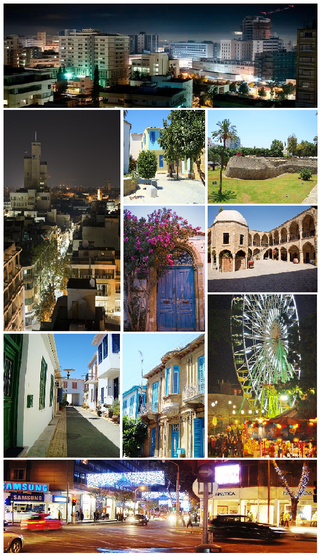
Nicosia is the capital and largest city of Cyprus. It is located near the centre of the Mesaoria plain, on the banks of the River Pedieos.

The United Nations Buffer Zone in Cyprus is a demilitarized zone, patrolled by the United Nations Peacekeeping Force in Cyprus (UNFICYP), that was established in 1964 and extended in 1974 after the ceasefire of 16 August 1974, following the Turkish invasion of Cyprus, and the de facto partition of the island into the area controlled by the Republic of Cyprus and the largely unrecognized Turkish Republic of Northern Cyprus in the north. The zone, also known as the Green Line, stretches for 180 kilometres from Paralimni in the east to Kato Pyrgos in the west, where a separate section surrounds Kokkina.
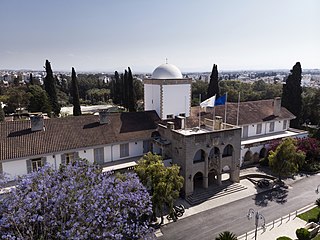
The Presidential Palace is the official residence and principal workplace of the President of the Republic of Cyprus. It is located close to the centre of Nicosia, the capital city of Cyprus, and is surrounded by a thick pine woodland.

The English School is a selective secondary school in Nicosia, Cyprus. It has a rigorous selection process for admittance. It is one of the secondary schools in Nicosia designated to be bi-communal, with both Greek and Turkish Cypriots being educated at the school.

The Pancyprian Gymnasium is the oldest still operational high school in Cyprus, founded in 1812.

The Cyprus Museum is the oldest and largest archaeological museum in Cyprus.

The Cyprus Government Railway was a 2 ft 6 in narrow gauge railway network that operated in Cyprus from October 1905 to December 1951. With a total length of 76 miles (122 km), there were 39 stations, stops and halts, the most prominent of which served Famagusta, Prastio Mesaoria, Angastina, Trachoni, Nicosia, Kokkinotrimithia, Morphou, Kalo Chorio and Evrychou. The CGR was closed down due to financial reasons. An extension of the railway which was built to serve the Cyprus Mines Corporation operated until 1974.
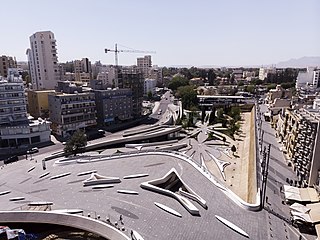
Eleftheria Square ; literally meaning Liberty Square, is the main square in central Nicosia, the capital city of Cyprus, in Europe. It forms the intersection of Ledra and Onasagorou streets with Stasinou, Omirou, Kostaki Pantelidi, Konstandinou Palaiologou and Evagorou avenues. It is considered one of Zaha Hadid's Top 35 projects.

The "Imprisoned Graves" are a set of graves in a small cemetery located in the Central Jail of Nicosia, where 13 EOKA fighters, during the 1955-1959 liberation struggle for the liberation of Cyprus from the United Kingdom, were interred. Nine of them were hanged by British executioner Harry Allen, three were killed in action and one died in hospital from wounds.

Notre Dame de Tyre or Our Lady of Tyre, or simply as Armenian church is a monastic church in Nicosia, Cyprus. It is located in the Arab Ahmet quarter, in Salahi Şevket Street, formerly known as Victoria Street.

Büyük Han is the largest caravansarai on the island of Cyprus and is considered to be one of the finest buildings on the island. Located in the capital of Cyprus, it was built by the Ottomans in 1572, the year after they had seized Cyprus from the Venetians. In the centre of the open courtyard is a mosque with a fountain for pre-prayer ablutions. It became the first city prison under British administration. After spending most of the 1990s being restored, the inn has been revived as a thriving arts centre, consisting of several galleries and workshops. There are also several courtyard cafes and souvenir shops.

The Kyrenia Gate, is a gate in the Nicosia walls, in North Nicosia, Northern Cyprus. It was the gate which was used for transport to the northern areas, especially Kyrenia.
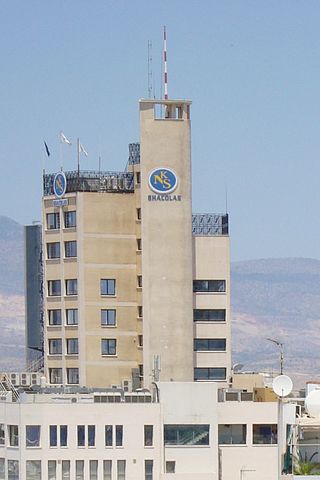
The Shacolas Tower or Ledras Tower is a highrise building in Nicosia, Cyprus. It was completed in 1959. It was built by Costas Manglis and was formerly known as the Manglis Tower, which housed the offices of the General Engineering and Hellenic Mining Company. It is located in the old town of Nicosia and it was the tallest building in Cyprus until 1978. The first 5 floors are H&M department stores and the 6th floor used to be a cafeteria offering a panoramic view of the old city. The 11th floor is an observatory and museum overlooking the whole capital. There are telescopes, binoculars and a recorded feature on the history of the capital.
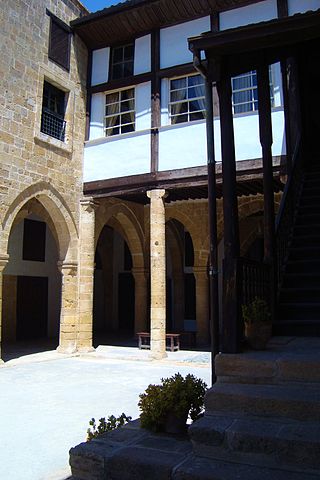
The Hadjigeorgakis Kornesios Mansion is situated near the Archbishopric, in the neighbourhood of Saint Antonios in Nicosia, Cyprus, where the wealthy notables of the Greek community traditionally used to live.

Sarayönü, officially Atatürk Square, is a square in North Nicosia. It is the centre of the Turkish part of the city and was the administrative center of the island for centuries.

Dereboyu Avenue, also known simply as Dereboyu and officially as Mehmet Akif Avenue, is the busiest avenue in North Nicosia, as well as its centre of entertainment. The term "Dereboyu" means "alongside the river", and although in the traditional sense this is only used for Mehmet Akif Avenue running alongside the Pedieos river, the term has expanded in meaning to denote a region extending to the neighbouring Osman Paşa Avenue.
Ayios Andreas or Tophane is a Neighbourhood, Quarter, Mahalla or Parish of Nicosia, Cyprus. In September 1945, the Ottoman name of Tophane was changed to Ayios Andreas, but there is no parish church of that name.

Kumarcilar Han is a caravansarai located in North Nicosia, Northern Cyprus. It is unknown when exactly it was built, however it is thought to be built around the end of the 17th century, is much smaller and modest when compared with Büyük Han. Similar to all caravansarai, the entrance leads to an open-air courtyard, which is surrounded by a two-storey building, originally containing 56 rooms. Those on the upper story were used by the travelers, while those on the ground floor were used for their animals and belongings. Since then, the Kumarcilar Han has entered into a state of disrepair, is in danger of collapse. Efforts to restore the building have been hampered, due to lack of funds.
Nicosia New General Hospital is the Nicosia district's main medical center. It opened in 2006, replacing Nicosia Old General Hospital.



















